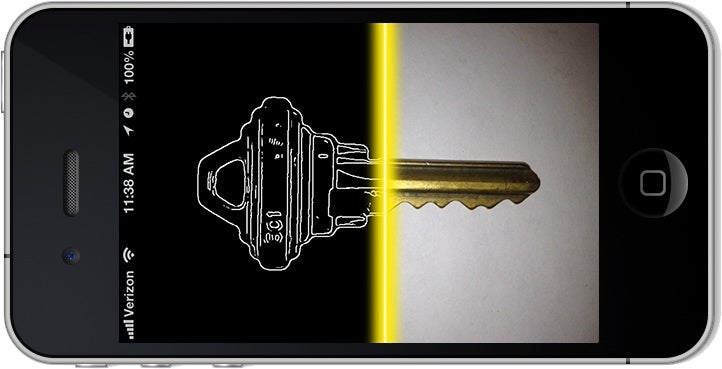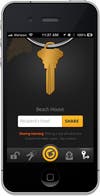Photograph Your House Key With This App, Then Print A Copy Anywhere
The app's creators think of it as "lockout insurance."

You hear myths of old-school locksmiths who are so in tune with their trade, they’re able to copy a key just from looking at a photo of it. The old-school-looking guys I talked with at one local shop said they couldn’t do that, but now there’s an app that can. KeyMe, the company that brought robot locksmiths to New York, has launched an iPhone app that is able to generate coded instructions that any locksmith can read, and make a copy of your key anywhere in the world.
The coded instructions are short and sweet. There’s one line that tells the smith which blank to start with. There’s a second line that’s a series of numbers–say “3,1,4,1,6”–that tells the smith at what depth to cut the key’s teeth.
Now, if you’re ever locked out of your house, “you can walk into a mom and pop locksmith and give them instructions to make your key,” says KeyMe founder Greg Marsh.
Just as with the KeyMe robot kiosks, you must have the foresight to snap a picture of your key and store it in KeyMe’s cloud database before you accidentally lock yourself out. Simply storing your key’s instructions is free. KeyMe charges $9.99 to retrieve the instructions when needed, and then you’ll pay whatever your local locksmith charges to cut the new key. (Those in New York City may also use their app-stored data to make a key at a KeyMe kiosk.) Overall, the total cost should be an order of magnitude less than the $100 that New York City area locksmiths usually charge to let people in after they’ve locked themselves out.
The app also lets you share your key’s instructions with someone else—perhaps a new roommate.
The app is only available for Apple devices. “Android is on our radar, but it will not be super soon,” Marsh says.
I tried the app yesterday with Marsh looking on. You must take a picture of your key with the app, following its exact instructions, for it to work. You can’t use any old picture of your key. That ensures that any key copiers must sign up for the app with a verified email address and credit card and must have physical possession of the key.
The app’s user instructions, which include putting the key on a white piece of paper and taking two pictures from a certain distance, help generate photos that the app’s software is able to “see” and understand. After all, the app must measure the depths of all of the key’s teeth in the photo and distinguish the teeth from shadows or the background. Crumbs on the paper can confuse the app, as can putting the key on a shiny surface, such as a tabletop, instead of a piece of paper.
I found the app easy to follow and soon had a digital copy of my front door key stored. I mail-ordered a physical copy, too, for $4.99. (Printing an instant copy direct from a KeyMe kiosk is $20.)

Sending a KeyMe Key
Marsh and his engineering team aren’t the first to demonstrate they’re able to automatically copy a key from a digital photo. Researchers at the University of California, San Diego, made a splash in 2008 when they wrote software that could recreate the instructions to make a key from a photo of the key taken 200 feet away.
Benjamin Laxton, who worked on that software as a graduate student, tells Popular Science he’s not surprised someone has thought of a commercial product using computer vision to copy keys. After publishing a paper on his work, he even got calls from people who wanted help turning his idea into a product. “It seemed like it was going to happen at some point,” says Laxton, who now works on computer vision software for the Scripps Institution of Oceanography.
Having an app like KeyMe in the world doesn’t necessarily make your keys much less secure, Laxton says. “Before this app or before the paper we wrote, it was entirely possible for a skilled individual to make a copy of a key after only having it for a short period of time,” he says. “This lowers the bar, I guess, a bit more.”
People should be aware this technology exists and be careful of leaving keys lying around, he says.
After generating the instructions for making my front door key in the KeyMe app running on Marsh’s iPhone, I wrote the code down in a notebook and took it to a locksmith close to the Popular Science office, Elite Locksmith on East 33rd Street. The instructions looked like a jumble of letters and numbers to me, but the two men working there said they would be able to cut a key from it. They would charge more for such a job—”probably like ten bucks,” one locksmith says, rather than their usual $2.50. The extra charge is for the extra work it takes to look up the different teeth depths and cut the key by hand.
One of the smiths pointed to the code in my notebook and said, “You should keep that in case you ever lose your key.”